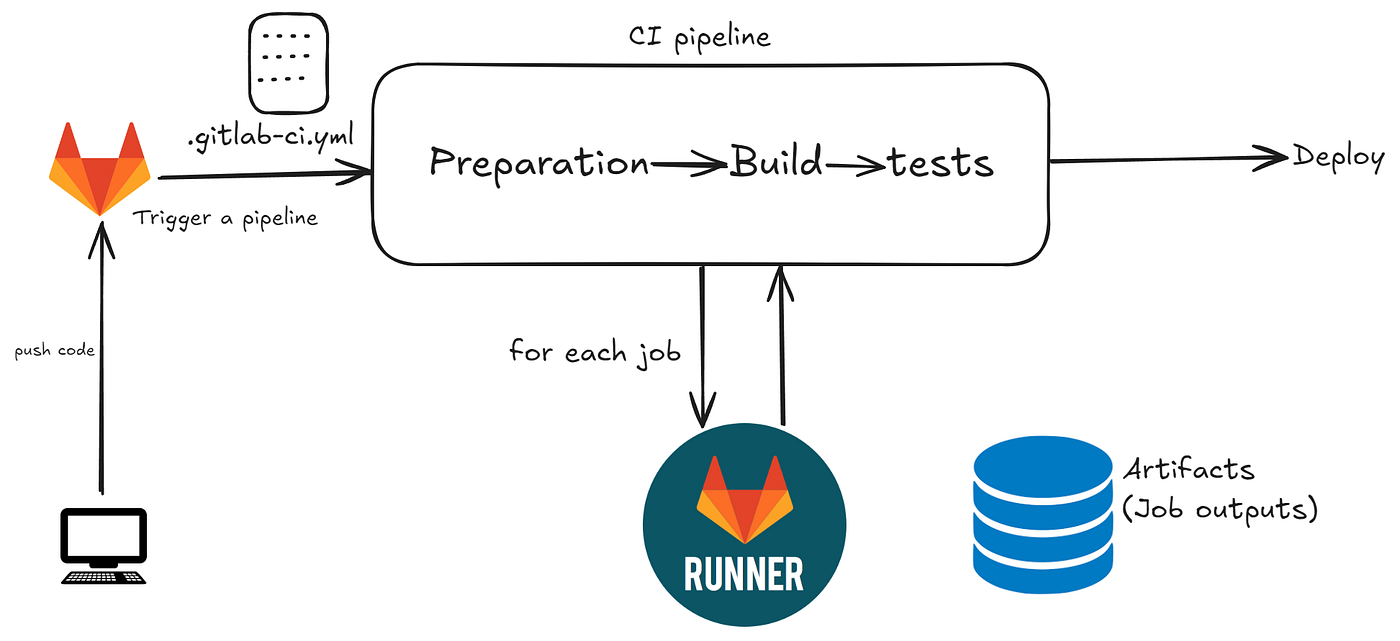Prerequisite: You have a GitLab account deployed on an AWS EC2 instance and have the necessary permissions to manage it.
Enable Job Artifacts and use an S3 bucket
### Job Artifacts
# gitlab_rails['artifacts_enabled'] = true
# gitlab_rails['artifacts_path'] = "/var/opt/gitlab/gitlab-rails/shared/artifacts"
###! Job artifacts Object Store###! Docs: https://docs.gitlab.com/ee/administration/job_artifacts.html#using-object-storage
# gitlab_rails['artifacts_object_store_enabled'] = false
# gitlab_rails['artifacts_object_store_proxy_download'] = false
# gitlab_rails['artifacts_object_store_remote_directory'] = "artifacts"
# gitlab_rails['artifacts_object_store_connection'] = {
# 'provider' => 'AWS',
# 'region' => 'eu-west-1',
# 'aws_access_key_id' => 'AWS_ACCESS_KEY_ID',
# 'aws_secret_access_key' => 'AWS_SECRET_ACCESS_KEY',
# # # The below options configure an S3 compatible host instead of AWS
# # 'aws_signature_version' => 4, # For creation of signed URLs. Set to 2 if provider does not support v4.
# # 'endpoint' => 'https://s3.amazonaws.com', # default: nil - Useful for S3 compliant services such as DigitalOcean Spaces
# # 'host' => 's3.amazonaws.com',
# # 'path_style' => false # Use 'host/bucket_name/object' instead of 'bucket_name.host/object'
# }
gitlab_rails['artifacts_enabled'] = true
gitlab_rails['artifacts_object_store_enabled'] = true
gitlab_rails['artifacts_object_store_remote_directory'] = "<gitlab-artifacts-bucket>"
gitlab_rails['artifacts_object_store_connection'] = {
'provider' => 'AWS',
'region' => 'ap-east-1',
'use_iam_profile' => true,
}Use roles to grant permissions to applications running on Amazon EC2 instances.
To set up an instance profile:
-
Create an IAM role with the necessary permissions. The following example is a role for an S3 bucket named
test-bucket:JSONCopy to clipboard
{ "Version": "2012-10-17", "Statement": [ { "Effect": "Allow", "Action": [ "s3:PutObject", "s3:GetObject", "s3:DeleteObject" ], "Resource": "arn:aws:s3:::artifacts-bucket/*" }, { "Effect": "Allow", "Action": [ "s3:ListBucket" ], "Resource": "arn:aws:s3:::artifacts-bucket" } ] } -
Attach this role to the EC2 instance hosting your GitLab instance.
-
Set the
use_iam_profileGitLab configuration option totrue.
Load configuration and restart gitlab
# Load configuration
sudo gitlab-ctl reconfigure
# RestartRunners – instance runner/shared runners
Three runner types
GitLab Runner has the following types of runners, which are available based on who you want to have access:
- Instance runners are available to all groups and projects in a GitLab instance.
- Group runners are available to all projects and subgroups in a group.
- Project runners are associated with specific projects. Typically, project runners are used by one project at a time.
To create an instance runner:
- On the left sidebar, at the bottom, select Admin.
- Select CI/CD > Runners.
- Select New instance runner.
- Select the operating system where GitLab Runner is installed.
- In the Tags section, in the Tags field, enter the job tags to specify jobs the runner can run. If there are no job tags for this runner, select Run untagged.
Run GitLab Runner in a container
run
docker run -d --name gitlab-runner --restart always \
-v /app/gitlab-runner/config:/etc/gitlab-runner \
-v /var/run/docker.sock:/var/run/docker.sock \
gitlab/gitlab-runner:v18.2.0register
$ sudo docker exec -it gitlab-runner /bin/bash # Enter the runner container and register.
$ gitlab-runner register --url <URL> --token <TOKEN> # Register in the runner container
Enter an executor:
docker
Enter the default Docker image (for example, ruby:3.3):
alpine:latest
Comments
I was recommended this website by my cousin I am not sure whether this post is written by him as nobody else know such detailed about my trouble You are amazing Thanks
Hi my loved one I wish to say that this post is amazing nice written and include approximately all vital infos Id like to peer more posts like this
Если вы ищите надежную [url=https://best-laser-correction.ru/]клиника по коррекции зрения[/url], обратите внимание на передовые технологии и доступные цены в нашей клинике. Мы выполняем процедуры с применением инновационных методик.
Если вы ищите качественный [url=https://ekrany-dlya-proektora1.ru/]купить экран для проектора[/url], то наш сайт предложит лучшие варианты по доступным ценам. Экран для проектора является важным компонентом в системах визуального отображения. Он позволяет получать четкое и качественное изображение от проектора. Если не использовать правильный экран, изображение получится смазанным и некачественным. Современные экраны изготавливаются из различных материалов, таких как ткань или пластик. Они могут быть как портативными, так и стационарными в зависимости от нужд. Определение подходящего экрана основано на параметрах, как уровень освещения и размер помещения. Образуется ряд вариантов экранов для проекторов, в том числе матовые и глянцевые. Матовые экраны подходят для помещений с ярким освещением, так как снижают блики. Экраны, обладающие высоким уровнем отражения, предоставляют более насыщенное и контрастное отображение. Переносные экраны просто перевозить и крепить в разных пространствах. Такие экраны компактно сворачиваются и экономят пространство, подходя для путешествий. Стационарные модели экранов монтируются на поверхности для регулярного использования в рабочих или домашних условиях. Применение экрана заметно повышает качество картинки, обеспечивая большую четкость. Оно становится более контрастным и детализированным для лучшего восприятия. Посетители более точно понимают содержание, что полезно в образовательных или деловых сценариях. Экраны защищают проектор от прямого воздействия пыли и повреждений. Экраны помогают сохранить работоспособность техники, уменьшая шансы на сбои. Также экраны предоставляют вспомогательные характеристики, как абсорбция шума, что повышает комфорт. Подбирая экран, обратите внимание на габариты комнаты для лучшего показа. Выберите экран подходящего размера, который соответствует расстоянию до зрителей. Удостоверьтесь в совместимости разрешения экрана с проектором для превосходного эффекта. Рассмотрите структуру экрана, которая гарантирует долговечность и удобство в чистке. Он обязателен в прочности, дающей возможность длительного использования без ухудшения. Также рассмотрите бюджет и отзывы пользователей для обоснованного решения.
Если вы заметили насекомых в доме, рекомендуем [url=https://travim-klopov.ru/unichtozhenie-klopov]травлю клопов с гарантией[/url], чтобы быстро и эффективно избавиться от проблемы. Появление клопов в жилых помещениях становится частой проблемой.